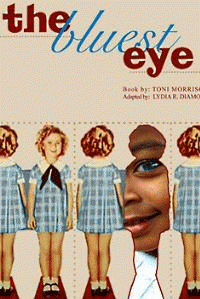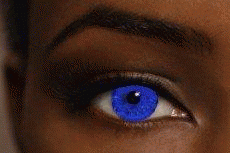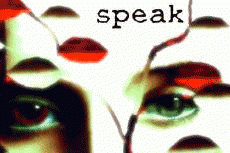Child of Fear
- The challenged books are not read in their entirety
- The material is universally approved by educators and critics
- Opinions of professionals are ignored
- Attitudes of students are never sought
- Those who disagree are ostracized or forced to leave
Young adults are particularly attuned to matters of injustice and hypocrisy. "I could not believe the hypocrisy of the censorship of books in the United States," Pico writes. Despite their own boundary testing and experimentation, teenagers can become almost hyper-aware of rule violation, unfairness and inconsistency in policy or procedure.
Coping with the moral and social dynamic of responsibility/authority –- censorship is like Kryptonite to juveniles! It’s an existential threat. The mere specter of censorship alarms young adults because it cuts against the idealism that is signature to the adolescent stage. Censorship sends teenagers into fits of indignant rage, despair and dark suspicion. "After twelve years of schooling," says Pico, "my education had in many ways finally begun."
Dylan Burns in Changing Minds makes similar statements. "This idealism led me to pursue, in high school, a number of other political activities." Like Pico, Burns agonizes over the awareness censorship has prompted. "Realizing this bizarre situation was probably the first political awakening of my young life, it angered and saddened me that this book was under attack from the intolerant and the fearful."
Coping with the moral and social dynamic of responsibility/authority –- censorship is like Kryptonite to juveniles! It’s an existential threat. The mere specter of censorship alarms young adults because it cuts against the idealism that is signature to the adolescent stage. Censorship sends teenagers into fits of indignant rage, despair and dark suspicion. "After twelve years of schooling," says Pico, "my education had in many ways finally begun."
Dylan Burns in Changing Minds makes similar statements. "This idealism led me to pursue, in high school, a number of other political activities." Like Pico, Burns agonizes over the awareness censorship has prompted. "Realizing this bizarre situation was probably the first political awakening of my young life, it angered and saddened me that this book was under attack from the intolerant and the fearful."
Considering the adolescent reaction to matters of censorship, a clear strategy suggests itself: make the issue of censorship a routine part of the discussion. Librarians can hold mock book burnings. Teachers can stage read-ins and do plays. Parents can join book circles and literary discussion groups.
Folks can’t value freedoms they don’t realize they have. A community that regularly celebrates the freeness of speech is prepared to recognize and respond to a challenge.
Folks can’t value freedoms they don’t realize they have. A community that regularly celebrates the freeness of speech is prepared to recognize and respond to a challenge.

Toni Morrison’s The Bluest Eye and Laurie Halse Anderson’s, Speak have both been challenged due to the controversial issues surrounding rape and sexual violence dealt with in the two novels. Both authors have spoken strongly and forcefully about censorship.
In the 2006 Platinum Edition of Speak, Anderson, who has authored children’s books as well as YA novels, includes some of her personal thoughts on censorship. Her remarks specifically relate to literature for young people. Anderson understands that parents, educators and other concerned adults who challenge books, often have good intentions and only wish to censor in an effort to protect teenagers. Anderson clarifies:
"But censoring books that deal with difficult, adolescent issues does not protect anybody. Quite the opposite. It leaves kids in the darkness and makes them vulnerable. Censorship is the child of fear and the father of ignorance. Our children cannot afford to have the truth of the world withheld from them."
The emotional and sexual abuse found in both The Bluest Eye and Speak, make them suitable for mature high school readers. Considering the sensitive nature of the material, no teenager should be required to read either book. But exposure to a diverse range of quality literature is an indispensable intellectual and emotional tool for young adults. Reading enables young people to tolerate the uncertainty, liminality and emotionality of adolescence.
Another great value of literature is that it allows young people to travel vicariously to other times and places. The Bluest Eye is fiction, but it communicates the very real experiences of its author, Toni Morrison. The book truthfully provides a perspective on American history and society – and is therefore useful as a social studies text.
While Morrison’s book explores harsh examples of social injustice and physical violence, young people who know and understand the mistakes of the past are less likely to repeat them. The Bluest Eye prompts readers to engage with and reflect on matters of social and personal responsibility, and thus it promotes moral development.
The Bluest Eye can provide a format for young people of diverse cultural backgrounds to assess their own thoughts and feelings about self-image and self-worth. Morrison’s story directly addresses several of the developmental tasks and markers of adolescence including: identity development; self-consciousness; sensitivity to criticism; physical awkwardness; sense of isolation; feeling outcast; and acute awareness of the social world and one’s place within it.

Rape is not a comfortable or simple thing to talk about. As a result, 60% of sexualized assaults are not reported to police. The fact is, our reluctance to openly and plainly speak about rape is at odds with how much we hear about it.
Sexual violence against young women is America's worst-kept secret. Rape is an issue in our newspapers and magazines, on our televisions and movie screens, in our neighborhoods and in our homes.
It is simply not reasonable or rational that we would censor books like Laurie Halse Anderson’s Speak and Toni Morrison’s The Bluest Eye – the few items that approach issues of sexual violence carefully, thoughtfully and honestly, and that seek to enlighten and heal.
We want to protect our children, but statistics testify to the truth. We can best protect young women and men by preparing them for the real world.

Community squabbles, political battles and culture wars can be extremely upsetting to young people. In Literature Review Process Finds Balance, Robert Klempen writes: "A divided community might make an interesting story for the evening news, but not for a child's education. The issue is just too important." Klempen then provides the precise recipe for a successful challenge response. His review of the process reveals that process itself "can act as a catalyst for peaceful conflict resolution." Reduced to its basic elements, Klempen’s approach involves two principals and an 8-part process.
Process-First Approach to Balancing the
Values and Beliefs of an Entire Community
A. Work in groups to think critically
B. Employ explicit problem-solving and decision-making strategies
C. Review Process:
In the 2006 Platinum Edition of Speak, Anderson, who has authored children’s books as well as YA novels, includes some of her personal thoughts on censorship. Her remarks specifically relate to literature for young people. Anderson understands that parents, educators and other concerned adults who challenge books, often have good intentions and only wish to censor in an effort to protect teenagers. Anderson clarifies:
"But censoring books that deal with difficult, adolescent issues does not protect anybody. Quite the opposite. It leaves kids in the darkness and makes them vulnerable. Censorship is the child of fear and the father of ignorance. Our children cannot afford to have the truth of the world withheld from them."
The Bluest I
Toni Morrison spoke out about the importance of fighting censorship in October 2009, after one of her books was banned at a Michigan high school:
"The thought that leads me to contemplate with dread the erasure of other voices, of unwritten novels, poems whispered or swallowed for fear of being overheard by the wrong people, outlawed languages flourishing underground, essayists' questions challenging authority never being posed, unstaged plays, canceled films -- and that thought is a nightmare. As though a whole universe is being described in invisible ink."
The emotional and sexual abuse found in both The Bluest Eye and Speak, make them suitable for mature high school readers. Considering the sensitive nature of the material, no teenager should be required to read either book. But exposure to a diverse range of quality literature is an indispensable intellectual and emotional tool for young adults. Reading enables young people to tolerate the uncertainty, liminality and emotionality of adolescence.
Another great value of literature is that it allows young people to travel vicariously to other times and places. The Bluest Eye is fiction, but it communicates the very real experiences of its author, Toni Morrison. The book truthfully provides a perspective on American history and society – and is therefore useful as a social studies text.
While Morrison’s book explores harsh examples of social injustice and physical violence, young people who know and understand the mistakes of the past are less likely to repeat them. The Bluest Eye prompts readers to engage with and reflect on matters of social and personal responsibility, and thus it promotes moral development.
The Bluest Eye can provide a format for young people of diverse cultural backgrounds to assess their own thoughts and feelings about self-image and self-worth. Morrison’s story directly addresses several of the developmental tasks and markers of adolescence including: identity development; self-consciousness; sensitivity to criticism; physical awkwardness; sense of isolation; feeling outcast; and acute awareness of the social world and one’s place within it.

Scholars and critics uniformly consider Toni Morison's work to be of the highest literary value. Her lengthy list of awards includes the 1978 National Book Critics Circle Award, the 1988 Pulitzer Prize for fiction, and the 1993 Nobel Prize in Literature.
In 2006, Sam Tanenhaus, then editor of the New York Times Book Review, sent a letter to approximately two-hundred “prominent writers, critics, editors and other literary sages, asking them to please identify the single best work of American fiction published in the last 25 years." The winner was Morrison's Beloved.
Margaret Atwood speaks of Morrison's "stature as a pre-eminent American novelist."
Literary critic, John Leonard, said Morrison’s The Bluest Eye delivers "a prose so precise, so faithful to speech and so charged with pain and wonder that the novel becomes poetry." Leonard continues: "I have said 'poetry.' But The Bluest Eye is also history, sociology, folklore, nightmare and music."
First published in 1970, Toni Morrison’s brave, Black American bildungsroman was a herald of the coming radical changes in Arts and Letters. The Nobel laureate’s extraordinarily rich use of language, depth of narrative and searing insight, place Toni Morrison’s The Bluest Eye among the most important works of American literature.
In 2006, Sam Tanenhaus, then editor of the New York Times Book Review, sent a letter to approximately two-hundred “prominent writers, critics, editors and other literary sages, asking them to please identify the single best work of American fiction published in the last 25 years." The winner was Morrison's Beloved.
Margaret Atwood speaks of Morrison's "stature as a pre-eminent American novelist."
Literary critic, John Leonard, said Morrison’s The Bluest Eye delivers "a prose so precise, so faithful to speech and so charged with pain and wonder that the novel becomes poetry." Leonard continues: "I have said 'poetry.' But The Bluest Eye is also history, sociology, folklore, nightmare and music."
First published in 1970, Toni Morrison’s brave, Black American bildungsroman was a herald of the coming radical changes in Arts and Letters. The Nobel laureate’s extraordinarily rich use of language, depth of narrative and searing insight, place Toni Morrison’s The Bluest Eye among the most important works of American literature.
Speak For Yourself
Morrison’s, The Bluest Eye, is about the potentially devastating socio-psychological effects of a filtered media. Similarly, Speak, by Laurie Halse Anderson, is practically a study in the dangers of withheld information and forced silence.
While not every book is appropriate for every teen, there are no instances where the move to suppress a work is ever a suitable choice. Censorship is intolerable to young people. It undermines their growth because it betrays a lack of trust. As adolescents are learning ways to think through their problems, denial and silence can be very dangerous models.
While not every book is appropriate for every teen, there are no instances where the move to suppress a work is ever a suitable choice. Censorship is intolerable to young people. It undermines their growth because it betrays a lack of trust. As adolescents are learning ways to think through their problems, denial and silence can be very dangerous models.
- Every 2 minutes someone in the U.S. is sexually assaulted.
- Every year there are about 213,000 victims of sexual assault
- 1 in 6 American women will be the victims of a completed or attempted rape in her lifetime.
- 9 of every 10 rape victims are female
- 44% of those rape victims are under age 18.
- Victims of sexual assault are more likely to be depressed, abuse substances and contemplate suicide
Rape is not a comfortable or simple thing to talk about. As a result, 60% of sexualized assaults are not reported to police. The fact is, our reluctance to openly and plainly speak about rape is at odds with how much we hear about it.
Sexual violence against young women is America's worst-kept secret. Rape is an issue in our newspapers and magazines, on our televisions and movie screens, in our neighborhoods and in our homes.
It is simply not reasonable or rational that we would censor books like Laurie Halse Anderson’s Speak and Toni Morrison’s The Bluest Eye – the few items that approach issues of sexual violence carefully, thoughtfully and honestly, and that seek to enlighten and heal.
We want to protect our children, but statistics testify to the truth. We can best protect young women and men by preparing them for the real world.
Through quality literature, and the reflection it promotes, young adults are empowered to protect themselves.

Process-First Approach
Community squabbles, political battles and culture wars can be extremely upsetting to young people. In Literature Review Process Finds Balance, Robert Klempen writes: "A divided community might make an interesting story for the evening news, but not for a child's education. The issue is just too important." Klempen then provides the precise recipe for a successful challenge response. His review of the process reveals that process itself "can act as a catalyst for peaceful conflict resolution." Reduced to its basic elements, Klempen’s approach involves two principals and an 8-part process.
Process-First Approach to Balancing the
Values and Beliefs of an Entire Community
A. Work in groups to think critically
B. Employ explicit problem-solving and decision-making strategies
C. Review Process:
- Formation of a Strategy Team (an inclusive review committee)
- Identification and Review of pertinent policy and processes
- Kepner-Tregoe's "Situation Appraisal" (Parent’s written concerns / investigation)
- Written Response (to parent's concerns from appropriate departments)
- Public Hearing and Interview (with people from both sides of the issue)
- Decision Analysis (based on standards and other materials)
- Situation Re-Appraisal (with all parties involved)
- Potential Problem Analysis (in advance of future challenges)










 12:01 AM
12:01 AM
 Vance Holmes
Vance Holmes

 Posted in:
Posted in: 
